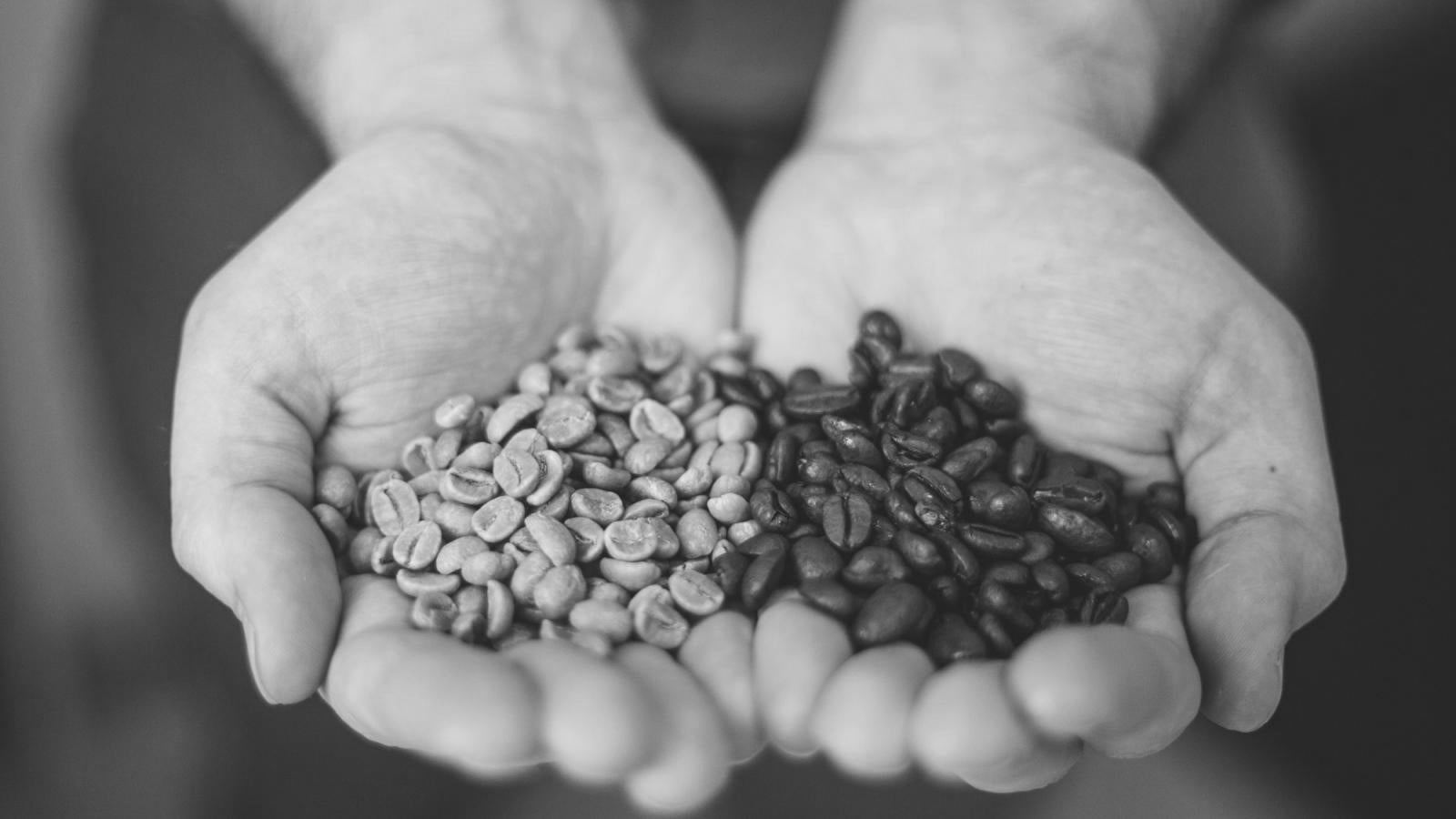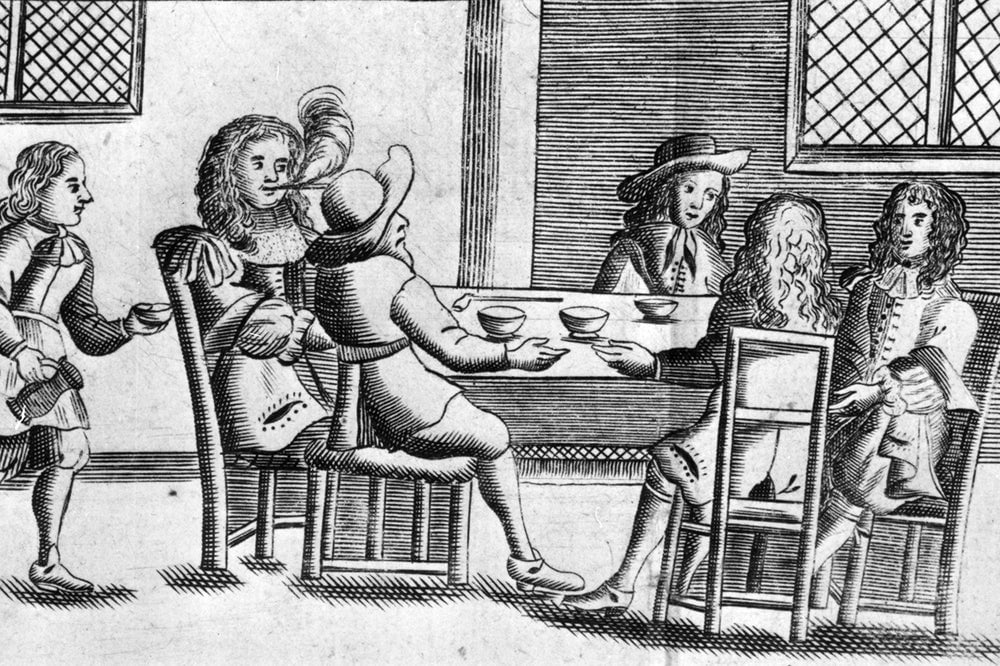The story of how coffee was first discovered and then spread to all of the major countries on Earth is a fascinating tale that includes romance, politics, religion, intrigue, heroics, deceit, greed, and innovation.
Coffee: but probe deeper into this sweet-sounding word – follow its roots to the the Italian caffè, French café, the Turkish kahve, and Arabic qahwa – and you’ll find a flow of time that reaches across Europe, through Asia, and into the African continent.
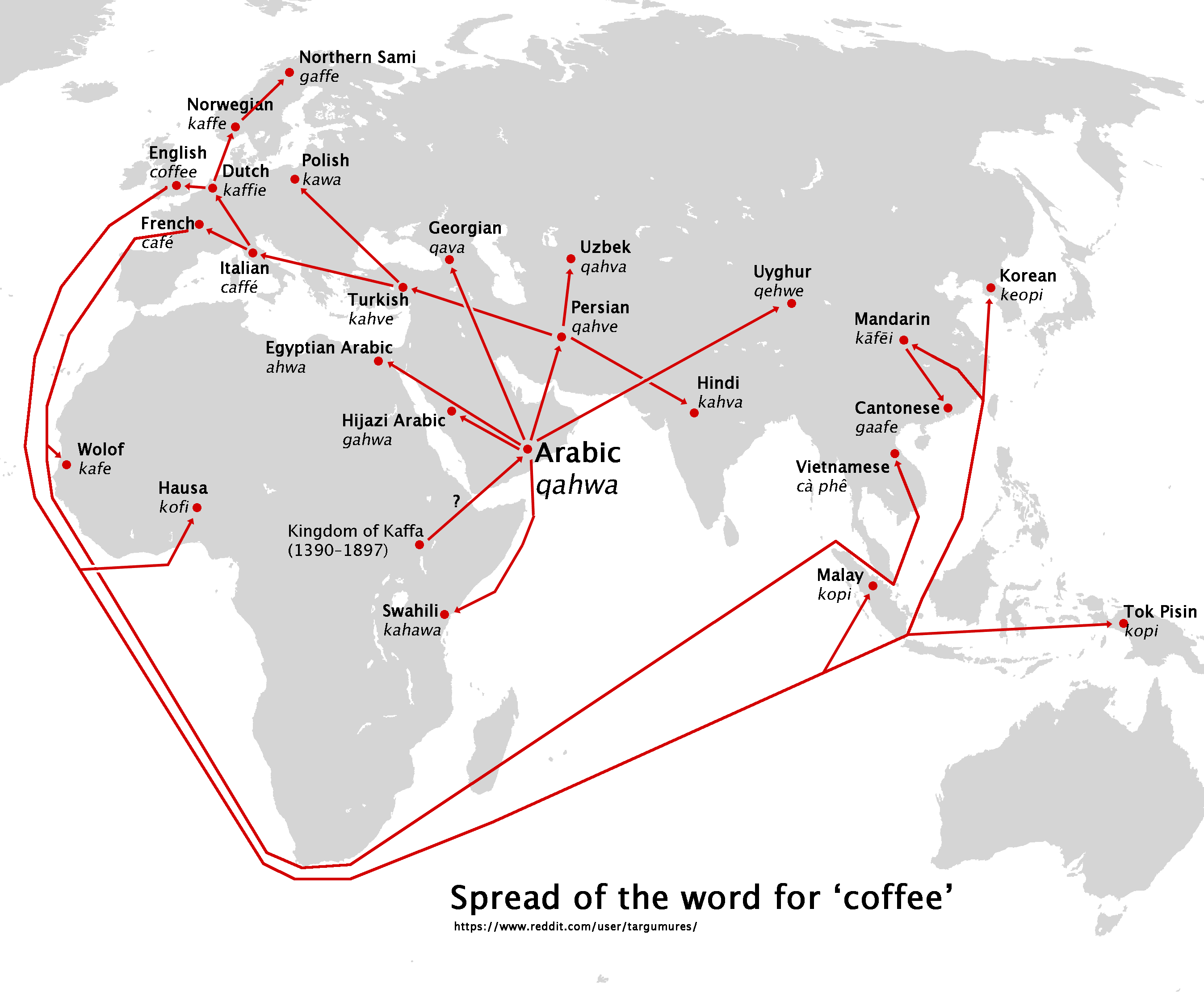
Etymology of coffee is not certainly known; however, there are various arguments about it. According to one view, it is an African word; Sir James Murray, in his New English Dictionary, argues that the word “coffee” is originally derived from the African language.
Another argument is that the word coffee originally comes from Arabic.
In the 15th century, the Arabic word “bunn”(bun) was used for both the coffee tree and its fruit.
Coffee fruit is called “kahva” or gahwa in Arabic. It has been claimed that the word “kahva” in Arabic is an altered version of “Kaffa”. Coffee is named after “Kaffa”, a city in the Soha region of Ethiopia, an upland region in Africa, which is considered to be the motherland of the coffee plant and the primary production center of coffee.
The word coffee, kahve, is used for the drink in Turkish.
The story of coffee includes many twists and turns – green coffee was smuggled across the ocean, presented to kings, carried along the ancient spice routes on the land and sea, banned by governments and clergies. For many people on earth coffee means imperialism, colonialism, and general exploitation.
Coffee trough history
Many of these dates are approximate
Early, up to 10th century
200 BC
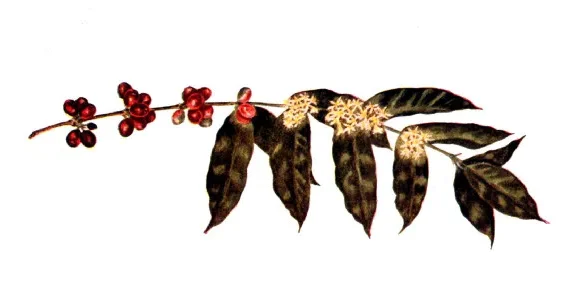
Possible cultivation of coffee in Yemen.
Archeological evidence is open to interpretation.
750 CE
Legendary Khalid observes the effect of coffee on goats and himself.
900 CE
Rhazes (Arab physician) mentions coffee under the name bunca or bunchum.
11th to 15th century
1000 CE
Avicenna (Arab physician and philosopher) describes the medicinal properties of bunchum
1258 CE
Sheik Omar (founder of Mocha) discovers coffee as a beverage at Ousab, Arabia. The legend of Sheik Omar
1350 CE
Persian, Egyptian, and Turkish ewers made of pottery are first used for serving coffee.
1400 CE – 1500 CE
Legendary Sufi mystic Baba Budan, is said to have smuggled alive coffee beans from Mocha to India when he returned from the Hadj – pilgrimage to Mecca. An early date of 1385 has been given for the occurrence, but Baba Budan probably went to India no earlier than 1600 and more likely about 1690.
From around the middle of the 15th century comes the earliest credible evidence of coffee consumption, and this was in Yemen’s Sufi monasteries.
Coffee is thought to have spread from Ethiopia to Egypt and Yemen where it was first roasted, and then by the 16th century it spread throughout the Middle East, Turkey, Persia, and into northern Africa. Later coffee spread from the Muslim regions to Italy and then very quickly throughout Europe. The Dutch then brought coffee to the East Indies and the Americas.
Specialized tools for coffee making appear in Ottoman empire and Persia hand roasters, Turkish cylindrical coffee mill, and the Turkish metal coffee boiler ~ cezve. Türk Kahvesi in Constantinople – Istanbul
1454 CE
Sheik Gemaleddin, mufti of Aden, learns of coffee in Abyssinia and sanctions its use in Arabia Felix.
1475 CE
Turkish law allows a woman to divorce her spouse if he does not supply a daily coffee quota.
16th century
1505 CE
Coffee plant is introduced into Ceylon (Sri Lanka).
1510 CE
Coffee is introduced into Cairo.
1511 CE
Kair Bey, governor of Mecca, prohibits the drinking of coffee. The sultan of Cairo revokes the prohibition. An Arabic poem reads:
“O Coffee, thou dost dispel all care, thou art the object of desire to the scholar.”
1517 CE
Sultan Selim I, conquers Egypt, brings coffee to Constantinople – Istanbul. Turk Kahvesi is born?
1524 CE
The kadi of Mecca closes the coffee houses. His successor reopens them under license.
1526 CE
Within a year of the Battle of Mohacs, coffee had reached Vienna by Turks.
1530 CE
Coffee drinking introduced into Damascus.
1532 CE
Coffee drinking introduced into Aleppo.
1535 CE
Religious riot against coffee houses. Chief judge settles the controversy by serving coffee at a meeting of disputants.
1543 CE
Soliman II forbids the use of coffee
1551 CE 1560 CE
1570 CE – 1580 CE
Religious dispute over coffee. Amurath III closes coffee houses by classing coffee with wine, but coffee use continues privately.
1573 CE
Rauwolf (German physician and botanist) travels to the Levant, mentions coffee in his writings:
“A very good drink they call Chaube that is almost as black as ink and very good in illness, especially of the stomach. This they drink in the morning early in the open places before everybody, without any fear or regard, out of clay or China cups, as hot as they can, sipping a little at a time.”
1580 CE
Alpinus Prospero Alpini, Italian physician and botanist, travels to Egypt and describes coffee.
1582 CE
First printed reference to coffee (chube) in Rauwolf’s Travels.
1585 CE
Gianfrancesco Morosini (city magistrate in Constantinople) reports to the Venetian senate of the Turkish use of cavee. The first Italian coffeehouse in Venice?
1587 CE
First authentic account of the origin of coffee by Abd-Al-Qadir Al-Jaziri writes Umadat Al-Safwa fi hill Al-Qahwa. (manuscript in Bibliotheque Nationale, Paris)
“No one can understand the truth until he drinks of coffee’s frothy goodness.”
Sheik Abd-al-Kadir, claims that Sheikh Jamal al-Dain al-Dhabhani (-1470), mufti of Aden was the first to use it:
“He found that among its properties was that it drove away fatigue and lethargy, and brought to the body a certain sprightliness and vigor.”
1592 CE
First printed description of coffee plant (bon) and drink (caova) in Alpini’s The Plants of Egypt.
1596 CE
Botanist Belli sends Egyptian coffee beans to the botanist de l’ Ecluse.
“Seeds used by the Egyptians to make a liquid they call cave.”
1598 CE
First printed reference in English to chaoua in a note in the translation from the Dutch of Linschooten’s Travels.
17th century
1600 CE
Coffee cultivation introduced into southern India at Chickmaglur, Mysore, Baba Budan.
1601 CE
Modern form of the word coffee appears in English in Sherley’s Travels.
1603 CE
Captain John Smith refers to the Turk’s drink coffa in his book of travels.
1610 CE
Sir George Sandys (English poet) visits the Middle East and describes the drinking of coffa.
1614 CE
Dutch traders visit Aden to study the possibilities of coffee cultivation and trade.
1615 CE
Pietro Della Valle writes to Mario Schipano in Venice that he will be bring some coffee with him, which he believes to be unknown in his native country. Coffee is introduced into Venice.
The first coffee sold in Europe was in pharmacies as a medicinal remedy.
1616 CE
The Dutch, Pieter Van dan Broecke, smuggles coffee plants from Mocha to Holland, but attempts to cultivate the plant fail.
1620 CE
Peregrine White’s wooden mortar and pestle (used for braying coffee) is brought to America on the Mayflower by his parents.
1625 CE
Sugar first used to sweeten coffee in Cairo.
1637 CE
Coffee drinking is introduced into England by Nathaniel Conopios, a Cretan student at Balliol College, Oxford.
1640 CE
Wurffbain, a Dutch merchant, offers for sale in Amsterdam the first commercial shipment of coffee from Mocha.
1644 CE
Coffee is introduced in to France at Marseilles by P. de la Roque.
1645 CE
Coffee comes into general use in Italy. First coffee house opens in Venice. Pope Clemente VIII was requested by some of his monks to outlaw the “Muslim” brew. He declined and said:
“This beverage is so good it would be a sin to let only pagans drink it!”
His subsequent “baptism” of coffee propelled it spread across Europe. Pope Clement VIII baptized coffee
1650 CE – 1685 CE
VIENNA – the Wiener Kaffeehaus – coffeehouse opend by Franz Georg Kolschitzky, a Viennese who had lived in Turkey. He opens the first coffee house in Vienna from spoils of battle for Vienna: bags of coffee that were left by Turkish Army.
London – the Oxford coffee houses
🙂
How do you take your coffee?
Me: Very, very seriously.
Due to the intellectual achievements of diverse personalities, like Galileo and Newton, the Age of Enlightenment (Reason) begins in western Europe, with coffeehouse and salon thinkers (philosophers) challenging the authority of the Church and government and promoting reason and individualism.
1672 CE
King Louis XIV is presented with a coffee tree from the Dutch. It is believed that sugar was first used to supplement coffee in his court.
1690 CE
The Dutch Pieter van der Broeck smuggles a coffee plant out of the Arab port of Mocha and become the first to transport and cultivate coffee commercially.
18th century
1720 CE
The “first caffè” in Italy rose in the eighteenth century in Venice, where in 1720 Caffè Florian opened at the commercial port frequented by Turkish merchants. This is followed by the Pedrocchi of Padua (1722), the Gilli in Florence (1733), the Greco in Rome (1760), and the Gambrinus of Neaples (1890).
1721 CE
First coffee house opens in Berlin, the German Kaffeehaus is born.
1722 CE
Jonathan Swift writes that:
“Coffee makes us sever, and grave, and philosophical.”
1723 CE
Chevalier Gabriel Mathieu de Clieu, after countless difficulties, manages to import coffee trees to Martinique in the Caribbean. Eventually, 90 percent of the world’s coffee spreads from this one plant.
1727 CE
The Brazilian coffee industry gets its start when Lieutenant colonel Francisco de Melo Palheta when the wife of French Guiana’s governor gave him a bouquet in which she hid cuttings and fertile seeds of coffee.
Vietnam cultivates its first coffee plantation.
1729 CE
Coffee cultivation begins in Mexico, others say 1790!
1730 CE
The British introduced coffee to Jamaica.
Coffee cultivation begins in Jamaica.
1732 CE
The one-act operetta Kaffee-Kantate (Coffee Cantata) is composed by Johann Sebastian Bach. At the time there was somewhat of a movement to forbid women from drinking coffee as some thought it would make them sterile. The tale begin when:
Father Schlendrian says: “You wicked child, you disobedient girl, oh! when will I get my way; give up coffee!”
Lieschen responds: “Father, don’t be so severe! If I can’t drink my bowl of coffee three times daily, then in my torment I will shrivel up like a piece of roast goat.”
1740 CE
In the Philippines, coffee has a history as rich as its flavor. The first coffee tree was introduced in Lipa, Batangas in 1740 by a Spanish Franciscan friar. From there, coffee growing spread to other parts of Batangas like Ibaan, Lemery, San Jose, Taal, and Tanauan. Batangas owed much of its wealth to the coffee plantations in these areas and Lipa eventually became the coffee capital of the Philippines.
1750 CE
One of Europe’s first coffeehouses, Caffe Greco, opens in Rome. By 1763, Venice has over 2,000 caffes.
1750 CE – 1760 CE
Guatemala cultivates its first coffee plantation.
1774 CE
Boston tea party – also part of the coffee history timeline – a rebellion by Americans against the new increased tea taxes put by the British. Dressed as Indians, the Americans dumped three boat loads of tea into harbor and then replaced it with coffee as their revolutionary beverage of choice.
1775 CE
Prussia’s Frederick the Great tried to block imports of green coffee, because Prussia had economic problems at the time, but public soon changed his mind. Frederick the Greats manifesto in favor of Germany’s more traditional drink:
“It is disgusting to notice the increase in the quantity of coffee used by my subjects, and the like amount of money that goes out of the country in consequence. My people must drink beer. His Majesty was brought up on beer, and so were his ancestors.”
1779 CE
Coffee plants shipped from Cuba to Costa Rica.
1790 CE
The coffee plant had spread to Colombia by 1790. The oldest written testimony of the presence of coffee in Colombia is attributed to a Jesuit priest, José Gumilla. In his book The Orinoco Illustrated (1730), he registered the presence of coffee in the mission of Saint Teresa of Tabajé, near where the Meta river empties into the Orinoco.
19th century
One of the first coffee brewing machines was invented in the early 1800s by German inventor, Franz Xaver close to Dusseldorf. This machine was called the “Dripolator” and worked by dripping hot water onto ground coffee beans. The coffee was then collected in a pot below. The De Belloy coffeemaker became the grandfather of the Indian filter coffeemaker
1800s
Kopitiam is a traditional Southeast Asian coffeehouse, and is most popular in Singapore and Malaysia. ‘kopitiam’ is made up of two words – ‘kopi’ meaning coffee in Bahasa Malaysia and ‘tiam’ meaning shop in Hokkien. All generations hang out at kopitiams, while drinking strong green tea and coffee with milk in their traditional forms.
1825 CE
Hawaii received coffee from Rio de Janeiro.
1850s
The first prototype of an espresso machine is created in France.
Edward Loysel de Santais created his coffee machine. He commercialized and marketed the machine by 1843. Santais machine wowed visitors at the Paris Exposition of 1855, producing one thousand cups of coffee an hour.
1868 CE
The invention of the machine and the method that would lead to espresso is usually attributed to Angelo Moriondo of Turin, Italy, who was granted a patent in 1884 for “new steam machinery for the economic and instantaneous confection of coffee beverage.”
1888 CE
In 1888, the first coffeehouse opened in Japan, known as Kahiichakan, which means a café that provides coffee and tea.
1893 CE
The coffee plant completed its journey around the world when it was introduced into Kenya and Tanzania just south of the original birthplace Ethiopia.
20th century
In Germany, afternoon coffee, the Kaffeeriecher – coffee smellers and Kaffeeklatsch – coffee chats became a daily ritual.
Coffee has been important in Italian, Austrian and French culture since the late 19th and early 20th centuries. The Italian caffès became meeting places for artists, intellectuals, and politicians and a defining feature of a newly emerging public sphere as well as a place increasingly associated with novelty and news. Vienna’s coffeehouses are prominent in Viennese culture and known internationally, while Paris was instrumental in the development of “café society” in the first half of the 20th century.
1900
Hills Bros starts to pack roast coffee in vacuum tins which marks the moment of the decline of the local roasting shops and coffee mills.
1901
Luigi Bezzera register a patent for the first espresso machine (steam-powered coffee machine)
Bezzera’s Patent for the Espresso Machine – 1903.
Japanese-American chemist Satori Kato of Chicago invents the soluble instant coffee.
1903
First commercial decaffeination process was invented by Dr. Ludwig Roselius.
The Coffee plant arrives to Madagascar.
1905
Luigi Bezzera’s second patent for a “coffee making machine” Until 1903, Desiderio Pavoni offered to pay 10,000 Italian lire to Bezzera for the right to commercialize the other patent. Immediately realizing the potential of such a machine, the couple began working on the project together.
1906
At the 1906 Milan Fair, the two men introduced the world to “caffé espresso“. It was a faster process of preparation.
The first mass-produced instant coffee was invented by George Constant Washington, an English chemist living in Guatemala.
1908
Melitta Bentz invents the first drip coffee maker with a filter made of blotting paper.
1910
Pavoni Ideale espresso machine
1920
As the Prohibition starts in the United States, coffee sales rise.
1933
Francesco Illy founded illycaffè.
Alfonso Bialetti invented the world’s first stove top espresso maker, the Moka, later to become the most popular maker in Italy.
1934
Hills was the first to package coffee in vacuum packed tin, resulting in a fresher product than competitors. Yet it was Francesco Illy in 1934 who brought the concept of pressurized packaging containers to the coffee market.
One of espresso’s defining characteristics, aside from its concentrated flavor and more syrupy body, is a top layer of foam known as the crema, which is a by-product of the high-pressure extraction process.
1936
Yuenyeung (coffee with tea) was invented in Hong Kong
1938
Instant coffee mass production is invented by the Swiss company Nestle as it assists the Brazilian government in solving its coffee surplus problem. It is named Nescafe.
1939
Achille Gaggia, files the patent no. 365726 for Lampo. This mechanism uses hot water pressure instead of steam and prepared a delicious espresso, characterized by a soft layer of “crema naturale.” This moment marks the beginning of the modern era of espresso.
Dr. Ernesto Illy develops the first automatic espresso machine. Illetta, the very first modern high pressure espresso machine, is created thanks to the patented system of separating water heating and pressure.
🙂
Q: Where do birds go for coffee?
A: To the NESTcafe
1940s
Aimed at preserving freshness by filling the containers with inert gas (nitrogen) rather than air, it enabled Illy to export his coffee across Europe. For many coffee companies, it remains the most effective way of preserving freshness during transportation.
The morning ritual of South Indian filter coffee brewing flourishes in Karnataka, Kerala and Tamil Nadu, with families procuring small lots of plantation coffee beans ground from neighborhood stores and preparing strong concoctions by pouring hot water over powder lined in a filter. This is mixed with sweetened milk and served in a steel tumbler and dabarah saucer, a set of containers used to cool the beverage.
The addition of chicory, a practice encouraged by the Coffee Board during World War II as a means of rationing supply, has now become tradition. The Coffee Board also started the Indian Coffee House chain during the 1940s which became a hub for socio-political movements in major cities through the decades after independence. This unique flavor of arabica coffee led to the term, Mysore Coffee being coined—Mysore being one of the largest cities in the Karnataka state of India.
New York, New York. Italian-American cafe espresso shop on MacDougal Street where coffee and soft drinks are sold. The coffee machine cost one thousand dollars.
1945
Achille Gaggia enhances the espresso machine with a manual piston that creates a high pressure extraction to produce a thick layer of crema.
Steam pressure in the boiler forces the water into a cylinder where it is further pressurized by a spring-piston lever operated by the barista. This eliminated the need for massive boilers and also increased water pressure to 8-10 bars, which we still use today.
It also standardized the size of espresso, since the lever groups could only hold an ounce of water.
The packaging method patented by Francesco Illy is a coffee “pressurization” system. The secret involves inserting nitrogen into the containers
1949
The Gaggia espresso is unique: the patented mechanism extracts the natural coffee oils and makes a delicious creamy layer on the top of the drink. Soon Achille Gaggia installs his machines in the most elegant Milanese bars, such as Motta and Biffi, with signs their windows that read “Crema caffè di caffè naturale.”
Over the next decade innovations within the industry took place at a remarkable rate as manufacturers attempted to appropriate and improve the new technology. Giuseppe Cimbali LaCimbali, Francesco Illy Illycaffè, Carlo Ernesto Valente Faema and La Marzocco as well, as many more unnamed creative minds were involved in forging the coffee culture of “Made in Italy”!
1955
The worldwide diffusion of espresso machines begins. At the famous Moka Bar, opened by Italian actress Gina Lollobrigida and first espresso bar of London, as well as other coffee bars like Bar Italia, Sirocci Bar, El Cubano, and The French House, Gaggia machines gleam on counters and serve 1000 people a day. The innovative “espressos with crema naturale” and cappuccinos delight young people, as well as the most known writers, authors, and actors.
1961
In 1961, Italy experienced a total eclipse of the sun. Ernesto Valente introduced the Faema E61 (eclipse of 1961). It used a motorized pump to provide 9 bars of constant and precise pressure without needing a lever. It was also the first heat exchange machine.
Heat exchange machines have a large boiler that keeps water around 240°F, ideal for producing steam for the steam wand. Brewing water makes its way to the group head through a coiled tube inside this boiler. This fresh water is flash heated as it makes its way through and is up to temperature for coffee brewing by the time it reaches the group head.
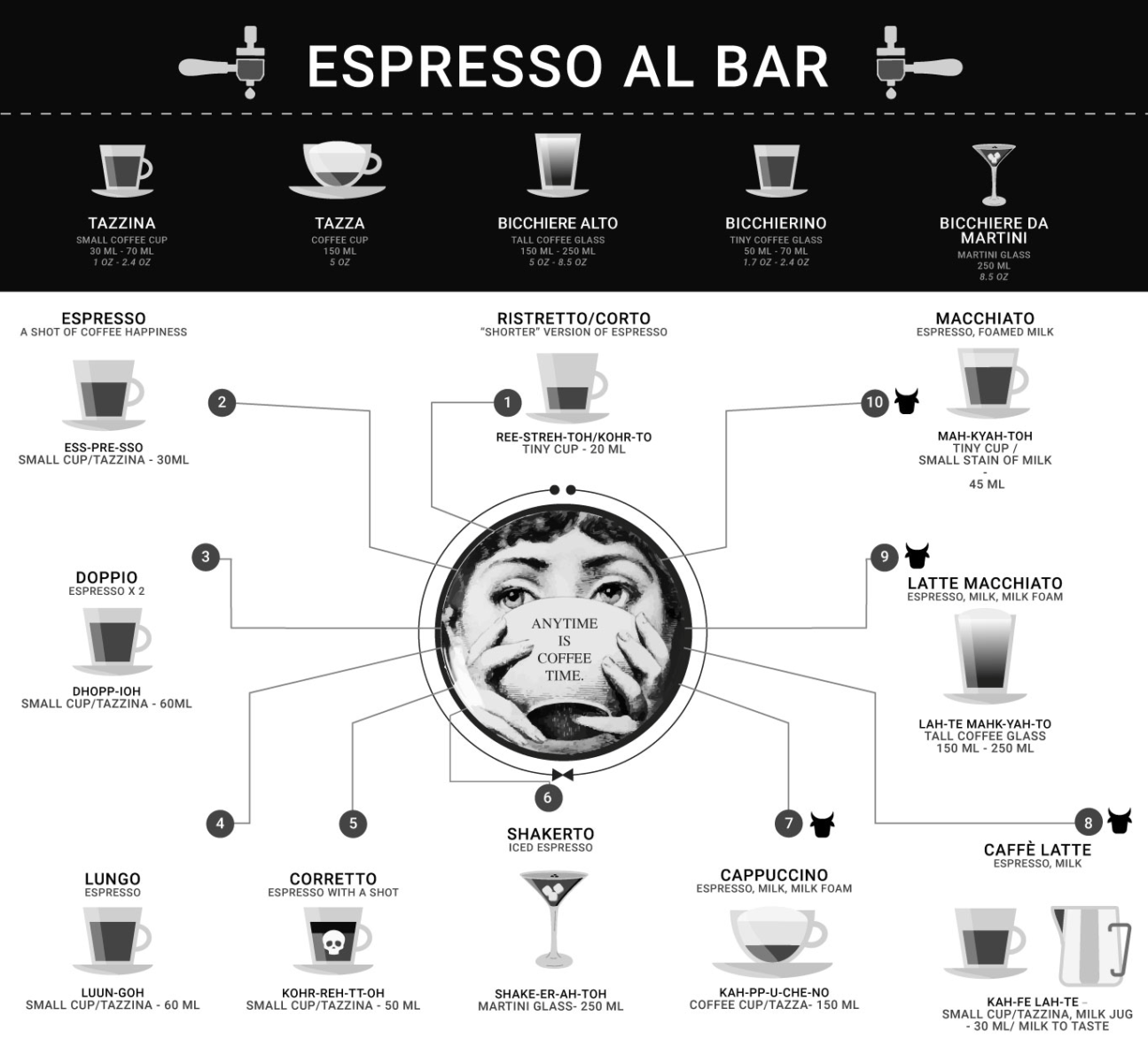
Espresso is thought of as neither a type of coffee, nor a form of beverage, but as the outcome of an Italian preparation process. Using about fifty beans of roasted coffee, finely ground and putting hot water through them at high pressure, we obtain an elixir, a concentrate where thousands of aromatic compounds burst out, to make espresso unique. Moreover, the sensations it offers does not end in the moment it is tasted, but persists. And so will the Italian coffee culture.
Coffee has become an iconic symbol of Italys’ table culture. Italian espresso has become closely identified with the country by both Italians and foreigners alike as have other coffee based beverages like cappuccino macchiato and other regional delicacies.
Espresso coffee has become a symbol of Italy in the world, representing not only the quality and taste of coffee, but also Italian culture and hospitality. All over the world, Italian caffés and bars have become a meeting and socializing place for people, an opportunity to discover and experience Italian culture and dolce vita.
1969
Apollo 11’s LEM Eagle broadcasts to the Johnson Space Center on 20 of july:
“If you’ll excuse me a minute, I’m going to have a cup of coffee.”
1971
In the 1970s, many kissaten (coffee-tea shop) appeared around the Tokyo area such as Shinjuku, Ginza, and in the popular student areas such as Kanda. These kissaten were centralized in estate areas around railway stations with around 200 stores in Shinjuku alone.
USA: Starbucks opens its first store in Seattle’s Pike Place public market.
“The Italians had created the theatre, romance, art and magic of experiencing espresso,” Schultz later said. “I was overwhelmed with a gut instinct that this is what we should be doing.” He wanted to recreate a similar kind of relaxing, hospitable environment in his own chain.
Whether or not Starbucks has succeeded in recreating the Italian experience is of course a matter of debate.
1986
The coffee pod market started. Nespresso S.A., a Nestlé Group company is founded. First portioned coffee system to the office coffee sectors in Switzerland, Japan and Italy are launched. Two machines, the C-100 and C-1100 are designed to resemble mini espresso machines.
1990s
In the 1990s, the Indian cafe chain Cafe Coffee Day ushered in an era of social interactions over coffee, introducing a new generation to the beverage with their slogan “A Lot Can Happen Over Coffee”.
1999
Trieste is the seat of the Università del Caffè (the University of Coffee. It holds courses for baristas, coffee producers and coffee bar managers. This competence center was created to spread the culture of quality coffee through training all over the world, to carry out research and innovation.
21th century
2011
UNESCO declared the “Coffee Cultural Landscape” of Colombia, a World Heritage site.
2017
There is even an Italian espresso machine on the International Space Station.
An American college course entitled “Design of Coffee” is part of the chemical engineering curriculum at University of California, Davis. A research facility devoted to coffee research is under development on the UC Davis campus.
2020
Italy launches bid for espresso coffee to be given a place on the UNESCO’s Intangible Cultural Heritage of Humanity list. Coffee culture is an essential part of Italian life; the day is defined by coffee. Italians take coffee seriously.
🙂
Customer: “Waiter, is this supposed to be coffee or tea?”
Waiter: “What does it taste like?”
Customer: “It tastes like gasoline!”
Waiter: “Well, sir, that would be the coffee. The tea tastes like turpentine.”
The extent of History of COFFEE is hardly to be seized here, there is still much more to discover.
Today
In addition to its economic significance, coffee also has a deep cultural significance. In many countries, drinking coffee is an important social ritual, and it is often consumed in a specific setting, such as a coffee house in Ottoman coffeehouses, or a café or bar in Italy.

Urban areas have adopted the trend of nano- and micro-roasters, coffee growing countries and their cities (Bogota, Sao Paulo, Hanoi, Penang, Havana, Bangkok and Jakarta) have created their own speciality blends that are sold in local coffee shops.
The popularity of artisanal coffee shops certainly owes a lot to the recognition that coffee can be more than a simple caffeine kick.
Today people care much more about the origins of the drink, its unique flavours, and the environment in which they drink it than ever before. And they see it as a way of connecting to others around them.
Coffee is flavoursome, fragrant and deeply rich in taste. It is often earthy with a discernible bitterness and balance of flavours where sweet, bitter and acidic notes all work pleasantly together.
It is this celebration of the experience, rather than the beverage alone, that has driven coffee’s global success, says José Sette, the executive director of the International Coffee Organization.
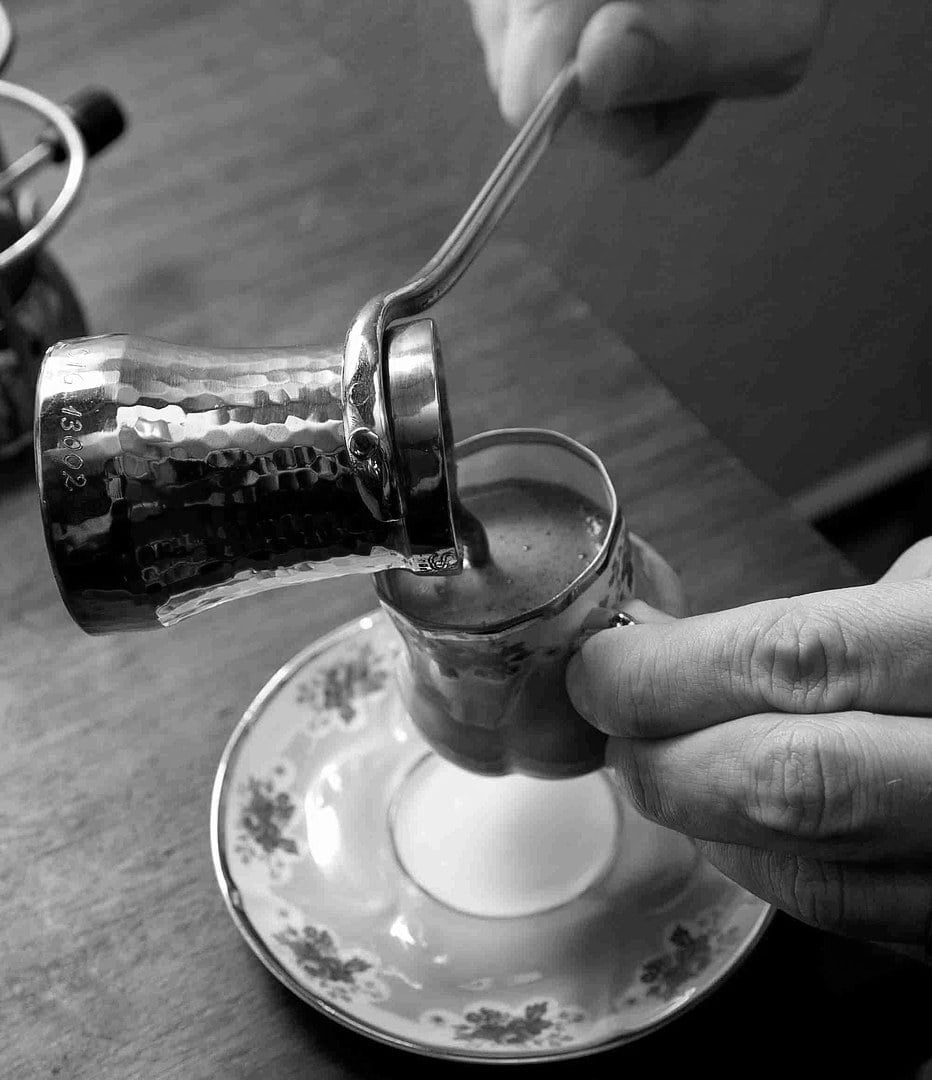
“Coffee is as popular as it is because it is a social currency,” he says. “It brings people together.”
This attitude, of course, dates right back to the start of coffee culture among the Sufis in the Middle East, where it remains central to many social rituals.
“In this proverbially hospitable area, coffee is the symbol of hospitality”
Claudia Roden

We love an Italian Moka, easy to make and just listen to the sputtering as it unleashes the coffee’s scent:

Innovations
The cultural history of coffee and it’s preparation is a tale of diversity and endless innovations of brewing methods.
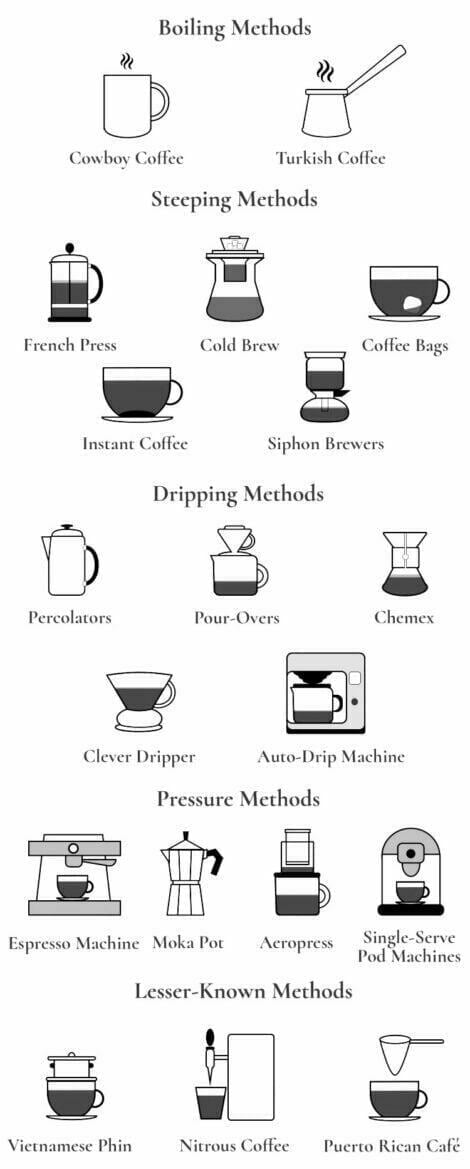
CoffeeAffection.com organized them in this graphic: boiling methods, steeping methods, dripping methods, and pressure coffee brewing methods.
Cold brew: Iced coffee is brewed hot and chilled over ice, while cold brew is left to steep in cold water for anywhere from 12 to 24 hours. The lower temperature and longer steep time allows the coffee to develop a smoother, sweeter flavor and higher caffeine content.
Green Coffee: Green coffee is unroasted coffee beans from Coffea fruits (Coffea arabica, Coffea canephora). It contains more chlorogenic acid than roasted coffee. The chlorogenic acid is thought to have health benefits. Green coffee also contains caffeine, but in lower amounts than regular coffee. Their extract is popular as a dietary supplement, but green coffee can also be purchased in whole-bean form and used to make a hot beverage, much like roasted coffee. This light green drink will not taste like roasted coffee, as it has a much milder flavor, – it’s said to taste more like herbal tea than coffee.
Don’t confuse green coffee with other caffeine sources, including coffee, black tea, and green tea. These are not the same.
Nitro Coffee: Nitro coffee is a type of cold brew coffee that is infused with nitrogen gas to give it a creamy, smooth texture. It has become increasingly popular in recent years, and can now be found in coffee shops and supermarkets across the country. Many people enjoy the creamy, velvety texture and smooth flavor of nitro coffee, which is often served straight from the tap like a draft beer.
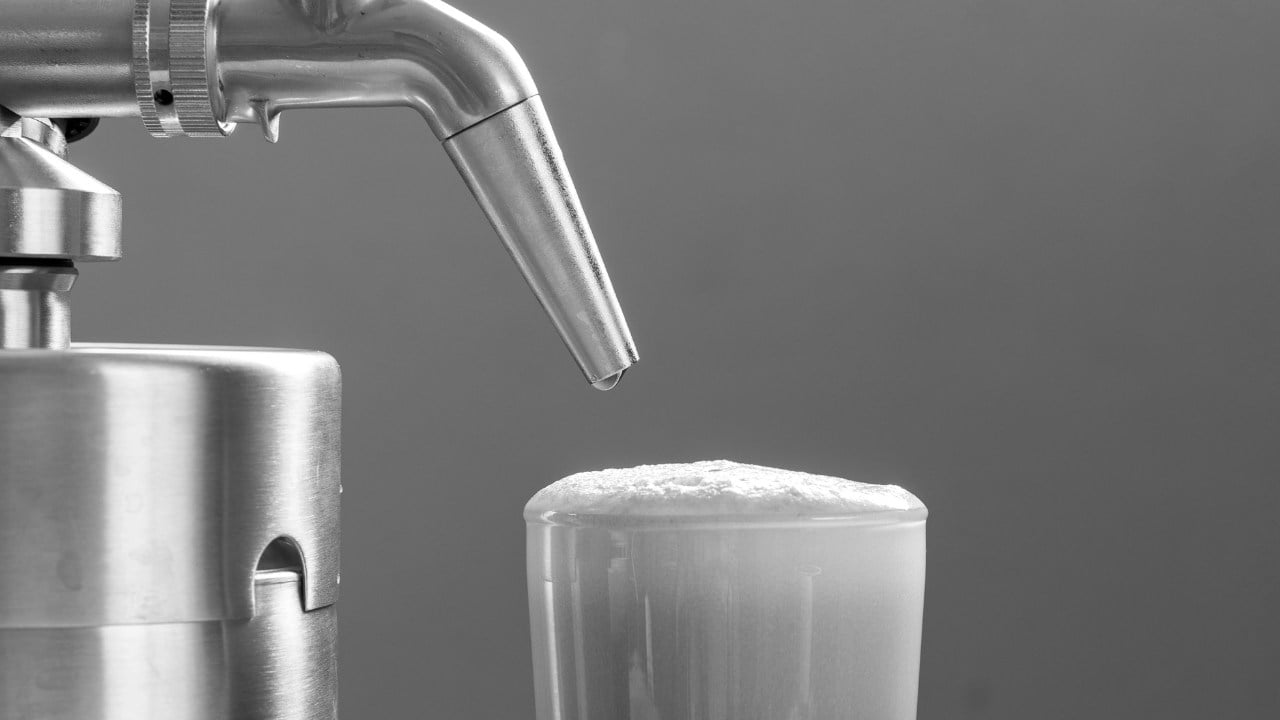
Degassing valve: One of greatest breakthroughs for coffee packaging in the 20th century was the invention of the degassing valve by Italian company Goglio. Prior to Goglio’s invention, coffee manufacturers would puncture holes in their coffee packaging to let carbon dioxide (CO2) escape. But this would not prevent exposure to oxygen, causing the coffee to become stale.
Today coffee is the world’s most popular beverage.
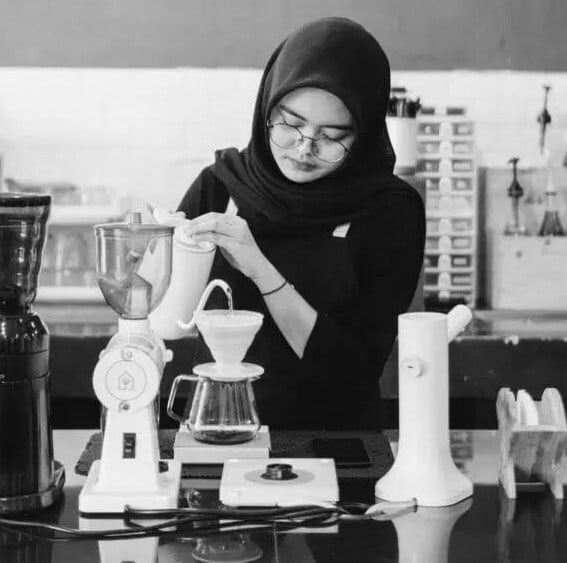
The Rise Of Coffee Culture In Asia. Azleen Abdul Rahim
Between 1992 and 2017, there has been a 6% year-on-year growth in demand for coffee in Asia as a whole – which is around three times as fast as the rest of the world. “It’s a very exciting market,” says Sette. Even so, the demand in Asia is still very far behind that of more established coffee-drinking regions: in 2017, Japan was the largest consumer in Asia, drinking 4.5% of the world’s coffee, while South Korea, imported 2% and China and Hong Kong lagging at just 0.76% each. The USA, in contrast, imported 20%, and Germany 11%.
More than 400 billion cups are consumed each year. It is the world’s largest commodity, second only to oil.
“Our culture runs on coffee and gasoline, the first often tasting like the second.”
Edward Abbey
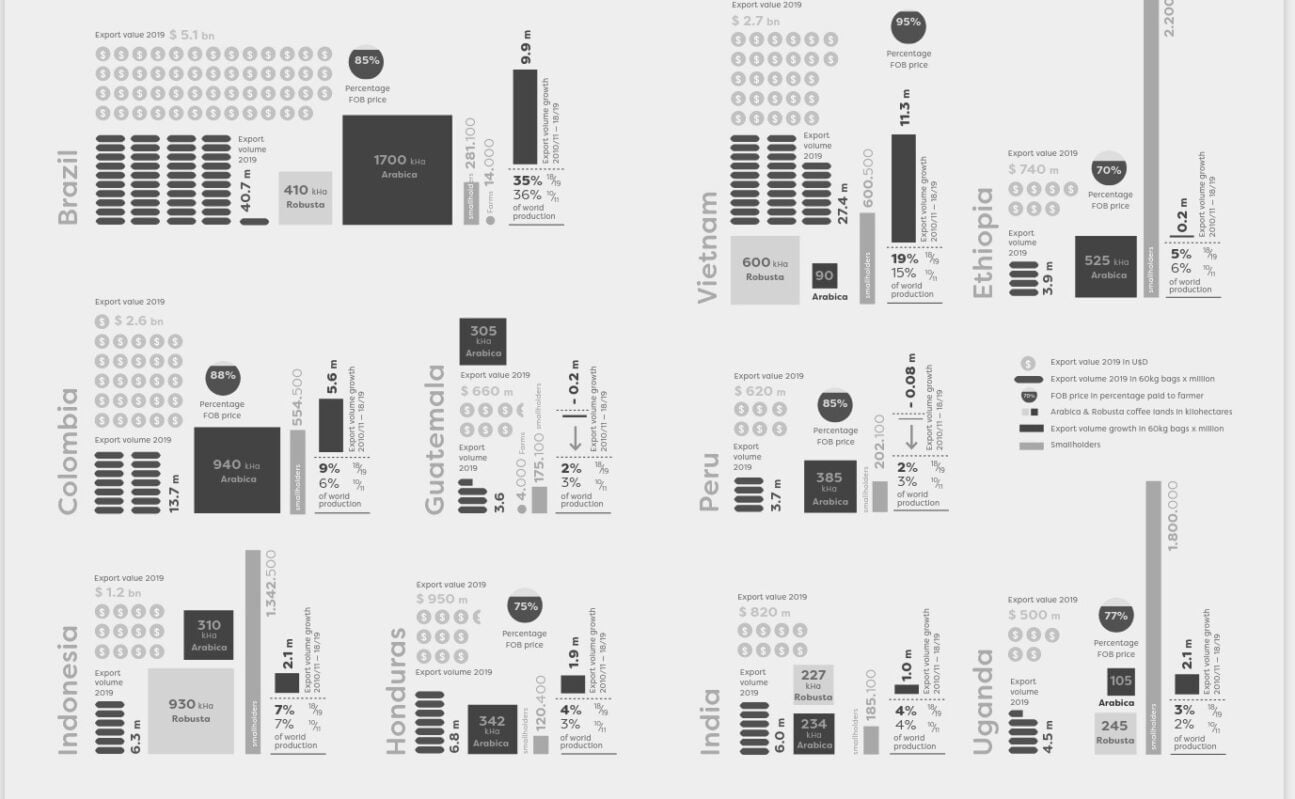
The history and cultural significance of coffee are fascinating and multifaceted. From its discovery in Ethiopia to its global impact on culture, coffee has played an important role in shaping our world. Its popularity and importance are evident in the millions of people who grow, prepare, and consume it every day. As we look to the future, it’s clear that coffee will continue to be an important part of our lives, both as a beverage and as a cultural touchstone.
While the coffee industry faces challenges, there is hope that it can become more sustainable and ethical, ensuring that coffee continues to be enjoyed for generations to come.
“Coffee, had a very good impact in many ways on our civilization, even though it was, for a long time, grown by slaves.”
historian Mark Pendergrast — author of Uncommon Grounds: The History of Coffee and How It Transformed Our World
Discover COFFEE on earthstoriez
~ ○ ~
Keep exploring:
Works Cited & Multimedia Sources
- Discover COFFEE on earthstoriez
- Stefan’s Florilegium. Herewith, Bear’s Chronology of Coffee for the Anachronist. coffee-msg.
- The espresso and coffee guide.
- The Turkish Coffee Culture and Research Association.
- Ukers W. H. All About Coffee. The tea and coffee trade journal.1922.
- TLW’s Coffee-Teascope.
- https://www.bbc.com/future/bespoke/made-on-earth/how-the-world-came-to-run-on-coffee
